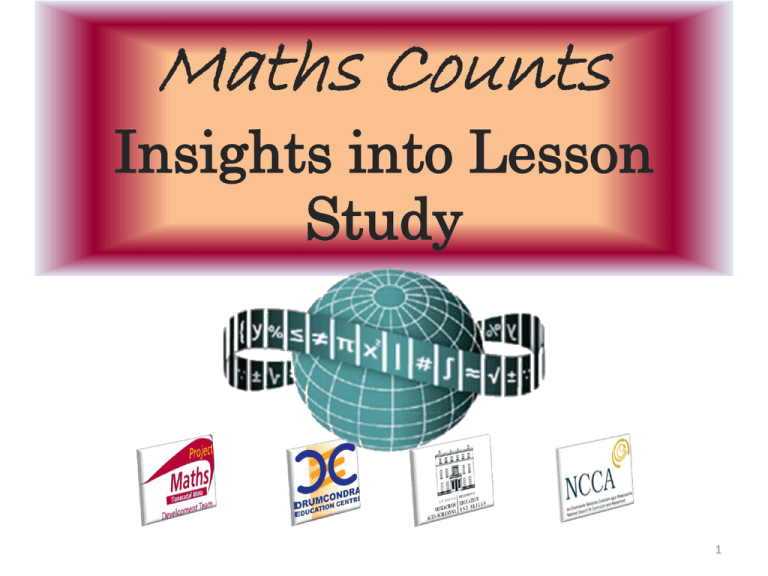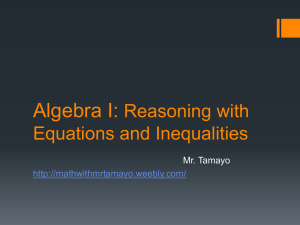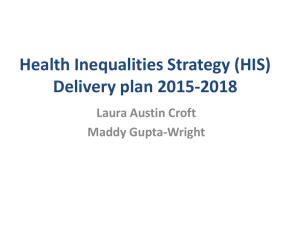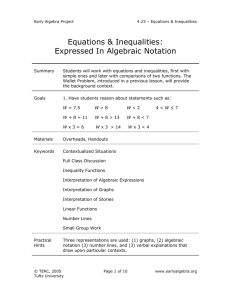Problem solving as a means not an end St. Mark`s
advertisement

Maths Counts Insights into Lesson Study 1 • • • • Sharon Mack, Irene Stone and Gemma Fay 3rd Years Problem Solving as a “Means” not an “End” Normally we teach the skills of inequalities and then use these to solve problems. • In this approach, we introduced the problem first, solved it, then used the problem to introduce inequalities and used our prior knowledge of equations to solve them. 2 • Introduction: Focus of Lesson • Student Learning : What we learned about students’ understanding based on data collected • Teaching Strategies: What we noticed about our own teaching • Strengths & Weaknesses of adopting the Lesson Study process 3 • Topic investigated was Problem Solving as a “Means” not an “End” • How we planned the lesson: The idea and methodology was used in the Project Maths workshop 8. Studied the lesson Decided how we would approach it and the timing of the lesson Photocopied the sheets 4 • Topic investigated was Problem Solving as a “Means” not an “End” • Resources used: Photocopied sheets with graph paper on the reverse PowerPoint Whiteboard 5 Our problem John has 18 ten-cent coins in his wallet and Owen has 22 five-cent coins in his wallet. They each decide to take one coin per day from their wallets and put it into their money box, until one of them has no more coins left in their wallet. When does Owen have more money than John in his wallet? 6 • Prior Knowledge: Patterns Tables, Graphs, words and formula Slope (Change) Variables and Constants Equations 7 • Format of my lesson: Students given an opportunity to read the problem Students worked on the problem by a method of their choice Teacher observed the students’ work and questioned them on their approaches Drew a table on the board and through class discussion arrived at the formula for John and Owen Represented the problem as 110 − 5𝑑 > 180 − 10𝑑 Draw comparisons between the inequality and an equation Solve the inequality using the skills of solving an equation Brought the answer back to the context of the question 8 Development of the inequality 9 • Learning Outcomes: Practise their knowledge of patterns More than one method to solve a problem Concept of one expression being bigger or less than another expression Relationship between equations and inequalities How to solve inequalities The necessity to bring all answers back to the context of the problem 10 • Why did we choose to focus on this mathematical area? Needed to introduce inequalities and saw this approach and wanted to try it. 11 • Enduring understandings: How patterns can be used to solve inequalities The relationship between equations and inequalities The ability to solve inequalities More than one method to solve problems (List, Table, Graph and Formula) 12 More than one method to solve a problem 13 • Student Learning : What we learned about students’ understanding based on data collected • Teaching Strategies: What we noticed about our own teaching 14 • Data Collected from the Lesson: 1. Academic e.g. samples of students’ work 2. Motivation 3. Social Behaviour 15 • What we learned about the way different students understand the content of this topic? Some students were: Reluctant to show their work in case it was incorrect. Reluctant to use Algebra in the first instance. Did not read the question correctly. Money box vs. wallet. 16 • What effective understanding of this topic looks like: Day 0 John has 180 and Owen 110. John and Owen have the same amount of money on day 14. Owen has more money on days 15,16,17 and 18. John has no more money on day 18, so problem stops. John’s formula is 180 − 10𝑑. Owen’s formula is 110 − 5𝑑. Owen is greater than John: 110 − 5𝑑 > 180 − 10𝑑. Apply their knowledge of solving equations to inequalities. 17 • Misconceptions/ Knowledge Gap: Graph going up done from the money box point of view. Also did not treat axis as lines 18 • Problem answered from wallet’s point of view rather than money box’s 19 • Stopped at day 15 20 • John has 1.80 on Day 1 instead of Day 0 21 • Confused Algebra skills 22 • Did not read the question properly; got days and weeks mixed up. 23 • Did not label the axes 24 The need to let this student know they are correct, but not all problems can be solved this way; hence we use inequalities 25 • Recommendations Encouraged those who confused wallet and money box to re-read the problem during the class. Have a money box and wallet in the class. Encourage students to label axes 26 • The understandings we gained regarding students’ learning as a result of being involved in the research lesson: Students engaged with the problem and remained engaged when problem translated to algebra and the inequality. Students also saw the difference between an equation and an inequality. Some students used tables, others graphs and others formulas. 27 • What did we learn about this content and approach to ensure we had a strong conceptual understanding of this topic? How building on patterns can be used to introduce equations and inequalities. Relationship between an equation and an inequality. The need to encourage students to put the answer back into the context of question. 28 What did I notice about my own teaching? • What was difficult? Timing to complete the table Not to intervene too soon Some students’ lack of confidence to start the problem or discuss the problem 29 • Was it difficult to facilitate and sustain communication and collaboration during the lesson? As some students answered from the money box’s point of view, I put the two sets of solutions on the board. I re-read the question and asked the students, which one we could use to find the answer to the problem. Put the formula as Owen > John rather than John < Owen. Why? 30 • Was it difficult to ask questions to provoke students’ deep thinking? What was happening to each person’s wallet? Was it only day 15 that Owen had more money? Why did we stop at day 18? Difference in 110 − 5𝑑 = 180 − 10𝑑 and 110 − 5𝑑 > 180 − 10𝑑? How do I solve an equation? What does 𝑥 > 14 mean in the context of this problem? 31 • How did I engage and sustain students’ interest and attention during the lesson? Students engaged with the context of the question because they could relate to it. Spotted misconceptions during the class and gave direction when required. 32 • How did I assess what students knew and understood during the lesson? Students’ work showed their understanding of the problem. Asked probing questions. Students were working in groups and discussing the problem. 33 • How did I put closure to the lesson? Showed how the problem could be solved by algebra. Solved the inequality. Discussed the meaning of 𝑥 > 14 in the context of the problem. While 𝑥 > 14 could mean 50, 50 did not answer this question in this context. Why? 34 • What understandings have I developed regarding teaching strategies for this topic as a result of my involvement in Lesson Study? I never would have thought of using patterns as an introduction to inequalities, but now see it is a brilliant approach. A slow lead-up to inequalities did not scare the students and they were still engaged at the end of the lesson. 35 • What changes would I make in the future, based on what I have learned in my teaching, to address students’ misconceptions? Use a context-based question to introduce equations. Encourage the students to spot patterns, where possible. 36 In future relate the change in the diagram, to the slope of the graph 37 Strengths & Weaknesses • As a mathematics team how has Lesson Study impacted on the way we work with other colleagues? Learned from my colleagues. Liked feedback from my colleagues. Do not spot everything yourself. Good or Bad. 38 Strengths & Weaknesses • Personally, how has Lesson Study supported my growth as a teacher? Confidence to be able to discuss ideas with my colleagues. Easier to see the learning as an observer. Privilege to see other teaching styles. Learning from each other. • Recommendations as to how Lesson Study could be integrated into a school context. More timetabled time needed for department meetings. 39










